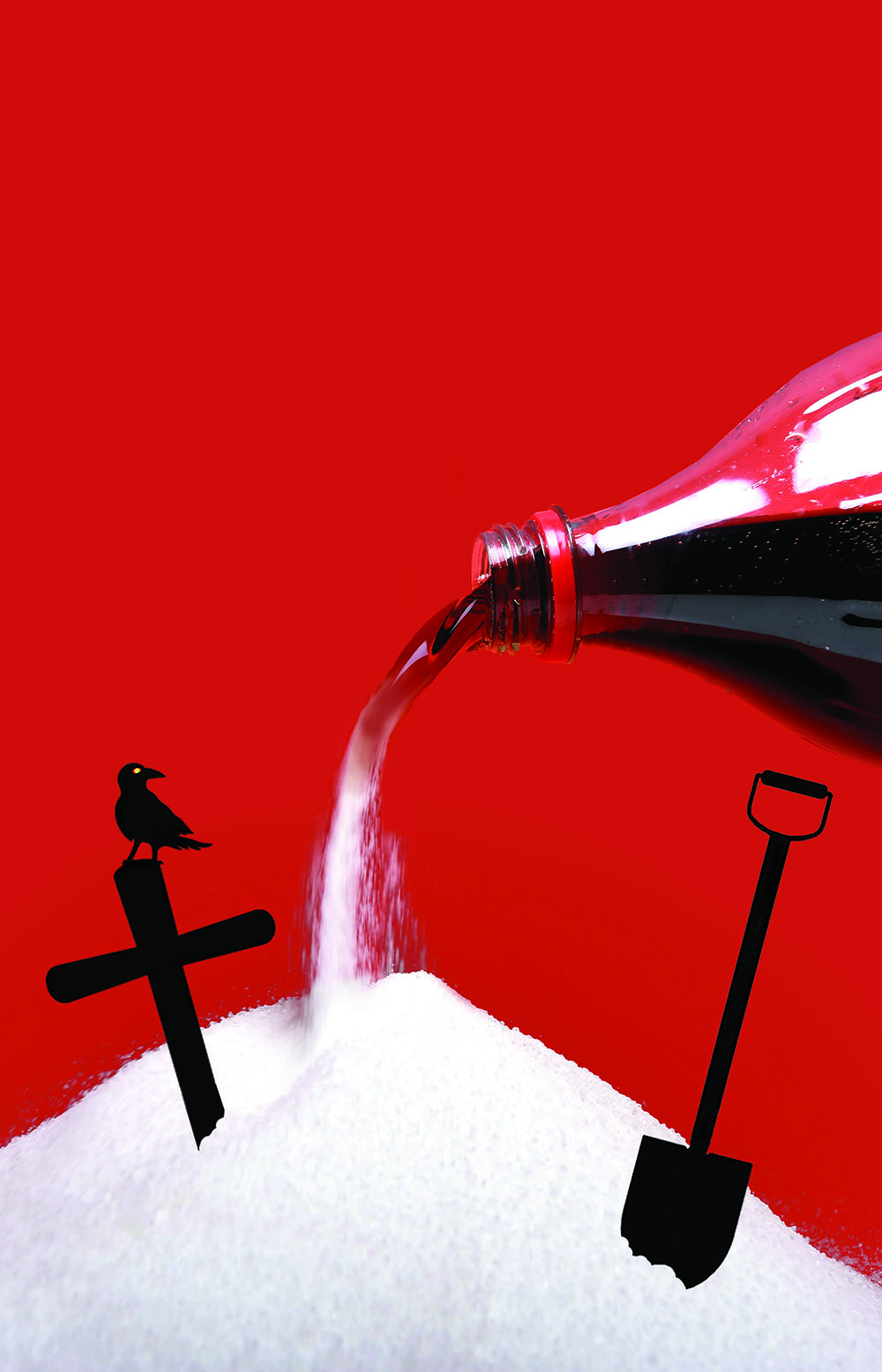By Caroline Knight
So … hands up, who knows about Candidiasis? Have you got it? Tricky question, I think. The chances are, if you have followed the standard Western diet for any real length of time during your life, you’re a prime candidate. The diet that the majority of the population consider to be normal because they see the supermarket shelves stacked high with this convenience food and “treats,” is actually a silent killer of many.
Most have been brought up to look upon sugar products as treats. The associations alone are dangerous; unhealthy food is so often used as a bribe for children. This, combined with other environmental factors, is part of the reason why widely recognized diseases like cancer, heart disease, strokes, and diabetes (among others) are, in my opinion, so prolific. But this is not acknowledged nearly as often as it needs to be. We are still placing too much faith in the pharmaceutical industry’s opinions and a good example of how these opinions are killing people daily is Candidiasis. I am willing to bet that the majority of allopathic doctors do not understand this issue on any real level; they wouldn’t have had to consider something caused as a result of terrible nutrition, given that they know virtually nothing about the subject. I know mine certainly didn’t, and I found this out the hard way.
You may by now have gathered that I am qualified to talk of this subject through personal experience of it. In my initial ignorance, I allowed doctors to take me on a painful, expensive, and fruitless journey, resulting in a lot of distress and no relief whatsoever. However, I do have this to thank for my current situation as in desperation I turned to alternative medicines, finding a new lease of life and a way to help others change their lives for the better.
The first and sometimes most difficult step is diagnosing this all-too-common condition. The symptoms are diverse and can be attributed to other causes, but some make it very obvious that you have this; there are also simple diagnostic tests that can be done at home. The problem is that leaving this undiagnosed can have dire consequences. At the very least you are likely to suffer from a myriad of ailments, symptoms of which your doctor would only attempt to tackle with potentially dangerous medicines; none of which will go any way toward curing you of the cause. Worst-case scenario – according to those who fully understand this topic, and a theory I fully endorse due to knowing many victims of it – you could end up with cancer. The two conditions are often concurrent, and the following authors found the respective percentages of patients showing coexistence of candida and cancer: R.L. Hopfer 79%, U. Kaben 80%, W. T. Hughes 91 %, and T.E. Kiehn 97%.
So what is Candidiasis and why would you have it?
Candida albicans is one of the most prolific forms of yeast affecting humans. Candida glabrata is another, more resistant strain of the candida species that infects men and women in 25 to 35% of cases. The yeast fungus cell produces over 75 known toxins and poisons that overwhelm the immune system, opening you up to all kinds of other conditions. Further, it widely interacts with hormones in the body.
If, like me, you grew up on anything other than an organic, convenience-food-free diet, you’re a candidate. If you were fed by your parents (albeit innocently) on endless sugary treats, additive-laden snacks, processed foods, red meat, and sugary or artificially sweetened drinks, the same goes. If you ever took the contraceptive pill or other hormone treatments, or took courses of antibiotics – you are at risk. A small selection of common symptoms include fungal skin infections such as eczema, psoriasis, acne, and nail conditions; irritable bowel syndrome, indigestion, gas, bloating, food sensitivity; thrush, period pain, impotence, infertility, urinary tract issues; nasal congestion, mucus, wheezing, sinusitis, asthma, ear and eye infections; muscle aches, painful joints, numbness, fatigue, lethargy; depression, headaches, mood swings, anxiety, poor concentration and memory, insomnia; cold hands and feet, body odor – and this list is by no means extensive. Combined with continued poor diet, if left to its own devices, the long-term effects of candida overgrowth can be widespread and devastating. If you have any of the bodily symptoms above, the chances are that the fungus has made the stomach lining porous, allowing it to spread from the gut into the cells of the body via the bloodstream and manifested externally.
How can you tackle it?
Well, this is the difficult part, depending on the severity of course. It is known to be one of the hardest conditions to beat, but it is possible with determination. Diet is of the utmost importance; necessary changes will include cutting out cow’s milk, calcium, most breads, wheat, gluten, and most importantly sugar. Sugars in our body are the yeast’s main meal, so that means no fruit, no alcohol, especially wine and beer – nothing fermented. Processed foods are a no-go, as are mushrooms (a fungus) and I’m afraid to say, stimulants like chillies and coffee. I imagine that many of you will have fallen off your chair at this point! Even salt (the processed kind) converts to sugar in the body. But all is not lost. Xylitol is a natural sweetener that looks and tastes the same, fights yeast and is much lower in carbs than sugar; you can even cook with it. Try Himalayan salt, which is rich in minerals. By sticking to low-carbohydrate vegetables, organic lean meats, wild-caught oily fish, eggs, and certain nuts seeds and oils, you will stand a much better chance of beating it. Combine this with antifungal supplements and you will be in an even better position to improve over time. It may appear that you are losing your favorite foods, but many of these foods only appeal due to addictive qualities produced in the way they metabolize in your body. Once you eliminate them, you are not likely to miss them after a while. Alcohol is a major issue for many; but if you must drink, unfermented spirits such as gin and vodka are a slightly better choice.
A highly recommended and invaluable tool for anyone suffering from this is Erica White’s Beat Candida Cook Book. It is a source of extensive information about the topic and includes a four-point plan for beating it, plus many recipes. It will give you a good idea of what you can and cannot eat, while demonstrating that the diet does not have to be as restricted as you might imagine. The only apparent positive aspect to the condition is that it will force you to re-evaluate your food choices, paving the way for you to eat much more healthily and strengthen your immune system greatly. I have no doubt in my mind that you will feel so much more energetic and fit as a result.
The natural remedies you can use
There are also many, many natural remedies out there that will tackle candida overgrowth in different ways. What works for you may be totally different to what works for someone else you know, due to your genetic make up and the strength of your immune system, plus the lifestyle choices and diet you have subscribed to over the years. So it may be a case of trial and error. It pays to remember that this can be a lengthy process, taking up to a year or even more in some cases to fully beat. If you are sensible, you should have relief from your symptoms fairly quickly. In my personal opinion, colloidal silver, fulvic acid, magnesium, Vitamin C, Lugol’s iodine, garlic, apple cider vinegar, and bicarbonate of soda are the best aids (and are also the most effective supplements against a wide range of other conditions). If you have the patience, hydrogen peroxide therapy is a great yeast killer, while diatomaceous earth, bentonite clay, and zeolite can carry yeast and heavy metals – another of its food sources – out of the body. Apricot kernels, coconut oil, and Lapacho (Pau D’arco) tea are helpful. You should take a 20-billion probiotic daily when using these supplements in order to balance the good bacteria in your gut, otherwise you may render certain supplements inert. You could also try Candiclear, tea tree, Vitamin D3, olive leaf extract, oregano oil, and cilantro. It pays to do your own homework on this condition, so as to arm yourself with as many potential weapons as possible.
It is also important to remember that you should not overload your liver with good supplements as it can only process toxins at a certain speed. If you do not cleanse it by liver packing and taking supplements like milk thistle, you may find that you enter a healing crisis where your body will spill out toxins back into the lymph and through the skin, making you feel quite ill. Also note that when yeast is dying off it can temporarily worsen the symptoms, making you think that the treatment hasn’t worked. It is not necessarily the case – perseverance is key. The most important factor of all is to listen to your body as it always tells us what we need, but all too often we are just not listening.
The options, let alone the strategy and routine required, can be mind boggling. What should you take for which symptom? How often should you take each thing? As someone who has experience of this issue, I’m happy to talk to anyone who wants help; however, the below links should be of assistance to you. Candidiasis brings about a personal challenge for most, as it demands that you rethink your entire eating history. It is also a major exercise in willpower. And a final warning: this is not something you can dip in and out of when you’re feeling unmotivated; once you slip back into eating the wrong food types, you may as well be waving a green flag to the remaining candida and you can probably expect a full-blown return – back to square one. But, be persistent and the rewards of beating it will be high. And for me, the alternative – namely a lifetime of miscellaneous and “unofficially” diagnosed sickness resulting in possible early death – is not an option.
Resources
www.yeastinfectionadvisor.com/ is a good source of information, but alongside natural remedies it does list some allopathic drugs as a possible option. I personally would never recommend this.
www.cancerfightingstrategies.com/fungalconnection.html explains the link between candida and cancer, and details a simple saliva test you can do to check if you have it.
www.phhealth.co.uk/products-page/ph-test-kits/ has pH testing that allows you to determine your acidity levels. If you suffer from Candidiasis, it is highly likely that your body is too acidic and you will need to alkalize. Your pH level should be around 7 or more and if it is lower, Candida has the opportunity to thrive in your body. You can find pH-testing strips here.




1 Comment
NHF UK admin · July 7, 2013 at 3:24 PM
Many thanks! Apologies for the delay in replying, NHF UK is undergoing a few changes administratively.